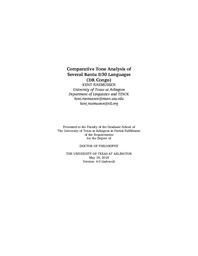| dc.description.abstract | This dissertation presents an analysis of the tonal systems of the Bantu D30 languages. There are 34 Bantu D languages in the Democratic Republic of the Congo (DRC), few of which have developed orthographies (Lewis, Simons, & Fennig 2013). These languages make use of contrastive pitch (tone), which is a source of difficulty in their analysis. I begin, therefore, with a review of literature arguing for a number of positions regarding the collection, analysis, and representation of tone data. Additionally, I describe the fundamentals of consonant-tone interaction, and some background on the Bantu D30 languages, including their genetic and geographic context.
My research describes infinitive and finite verb forms, mostly in Ndaka [ndk] and Mbo [zmw], though also including data from other Bantu D33 languages Budu [buu], Nyali-Kilo [nlj], Vanuma [vau] and Bantu D32 Bɨra [brf]. I further compare the Bantu D30 languages, in order to provide insight into the analysis of consonant-tone interaction (CTI). Specifically, these descriptions and comparisons form the basis for my argument that a synchronic application of Bradshaw (1999)'s [L/Voice] cannot account for Bantu D30 data. Rather, a historical and comparative perspective is needed to account for data not predicted by Bradshaw (1999), if her fundamental claims are to remain intact.
This research has two primary aims. First, I describe the three lexical verb root classes by tone in Ndaka and Mbo, along with data from other Bantu D30 languages. Second, I provide comparative data in the Bantu D30 languages. These comparative data allow one a better view of certain consonants of the Bantu D30 languages. A diachronic view of these consonants is further helpful in understanding current tone patterns as the result of historical consonant-tone interaction (CTI). Ultimately, this work contributes to the understanding of the genetic relationships between the Bantu D30 languages, which is somewhat debatable at present.
Perhaps the greatest theoretical contribution of this dissertation is a new model of tonogenesis (the creation of new tone melodies). This new model provides an account for the large majority of available Bantu D30 data fitting a distribution as expected by Bradshaw (1999)'s [L/Voice], while at the same time accounting for a non-trivial number of exceptions to that distribution. This model accounts for the Bantu D30 data without rejecting Bradshaw (1999), but also provides a model for how tonogenesis may have occurred, which can then also be applied to the origin of tone melodies in other languages. | |


